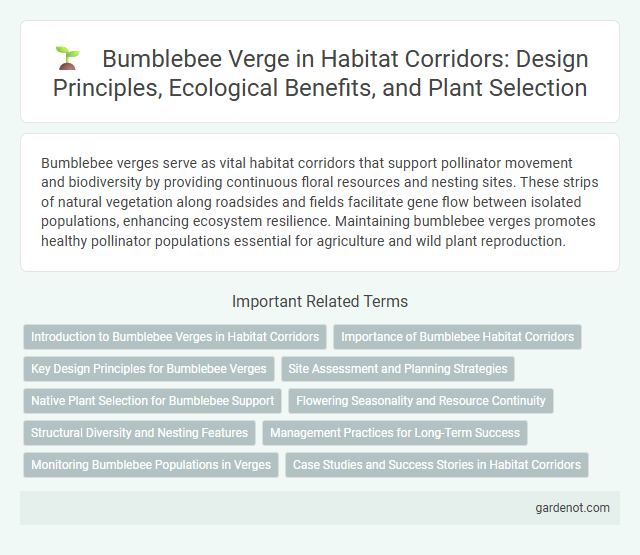Bumblebee verges serve as vital habitat corridors that support pollinator movement and biodiversity by providing continuous floral resources and nesting sites. These strips of natural vegetation along roadsides and fields facilitate gene flow between isolated populations, enhancing ecosystem resilience. Maintaining bumblebee verges promotes healthy pollinator populations essential for agriculture and wild plant reproduction.
Introduction to Bumblebee Verges in Habitat Corridors
Bumblebee verges serve as essential habitat corridors that support pollinator populations by providing rich floral resources and nesting sites along roadsides and field margins. These corridors enhance landscape connectivity, enabling bumblebees to forage effectively and maintain genetic diversity across fragmented habitats. Establishing and managing bumblebee verges contributes to biodiversity conservation and supports ecosystem services such as pollination in agricultural and natural environments.
Importance of Bumblebee Habitat Corridors
Bumblebee habitat corridors play a crucial role in sustaining pollinator populations by enabling safe movement between fragmented floral resources and nesting sites. These corridors enhance genetic diversity and resilience against environmental changes, supporting ecosystem health and agricultural productivity. Establishing and maintaining bumblebee verge corridors can significantly mitigate habitat loss and promote biodiversity conservation.
Key Design Principles for Bumblebee Verges
Bumblebee verges are designed with native flowering plants that provide continuous nectar sources throughout the bumblebee active season, supporting foraging and nesting needs. These corridors incorporate diverse plant species to enhance floral resource availability and promote habitat connectivity, enabling safe movement between fragmented habitats. Soil management practices ensure suitable nesting conditions, while minimizing pesticide use protects bumblebee populations in these strategically located verge habitats.
Site Assessment and Planning Strategies
Bumblebee verge site assessment involves detailed ecological surveys to identify existing floral diversity and nesting habitats critical for bumblebee populations. Planning strategies prioritize native wildflower planting, maintaining continuous floral resources throughout the season to support pollinator foraging and breeding cycles. Integrating habitat corridors with adjacent green spaces enhances connectivity, promoting genetic flow and resilience of bumblebee communities.
Native Plant Selection for Bumblebee Support
Bumblebee verges featuring native plant selection boost habitat corridors by providing essential forage and nesting resources, fostering pollinator health and biodiversity. Native wildflowers such as knapweed, clover, and vetch offer abundant nectar and pollen throughout the bumblebee active seasons, enhancing their foraging efficiency. Establishing diverse native plant communities in verge habitats strengthens ecosystem connectivity and supports resilient bumblebee populations critical for pollination services.
Flowering Seasonality and Resource Continuity
Bumblebee verges provide essential flowering seasonality by supporting a diverse range of native flowering plants that bloom sequentially from early spring to late autumn, ensuring continuous nectar and pollen resources. This extended flowering period enhances bumblebee foraging efficiency and colony development by maintaining stable food availability throughout critical life stages. Effective habitat corridors with well-managed flowering seasonality promote resource continuity, crucial for sustaining healthy bumblebee populations and enhancing pollination services in fragmented landscapes.
Structural Diversity and Nesting Features
Bumblebee verges provide essential habitat corridors characterized by high structural diversity, including varied vegetation heights and flowering plant species that support foraging and nesting. These corridors feature abundant nesting substrates such as bare soil patches, old rodent burrows, and tussock grasses, critical for bumblebee colony establishment. Maintaining structural complexity ensures connectivity between fragmented habitats, enhancing bumblebee survival and pollination services.
Management Practices for Long-Term Success
Bumblebee verge management prioritizes periodic mowing cycles tailored to bloom periods, ensuring floral diversity that supports pollinator foraging throughout the season. Implementing pesticide-free zones within these corridors significantly enhances bumblebee population resilience by reducing toxic exposure. Monitoring soil health and native plant species composition helps maintain habitat quality critical for long-term bumblebee conservation.
Monitoring Bumblebee Populations in Verges
Monitoring bumblebee populations in verge habitats provides critical data on pollinator health and biodiversity trends. Researchers utilize standardized surveys and citizen science initiatives to track species abundance, diversity, and seasonal activity patterns along these green corridors. This ongoing monitoring supports habitat management decisions aimed at enhancing forage resources and connectivity for bumblebee conservation.
Case Studies and Success Stories in Habitat Corridors
Bumblebee verges have proven effective in enhancing habitat corridors by providing crucial foraging and nesting sites, as demonstrated in case studies from the UK and Germany where pollinator populations significantly increased. In the UK, roadside verges planted with native wildflowers facilitated bumblebee movement across fragmented landscapes, boosting genetic diversity. German projects incorporating bumblebee-friendly vegetation along agricultural corridors reported higher colony densities and improved ecosystem services, showcasing successful habitat connectivity restoration.
Bumblebee verge Infographic

 gardenot.com
gardenot.com